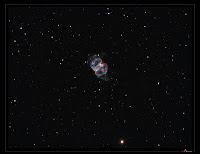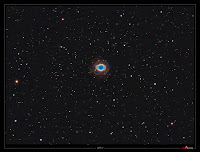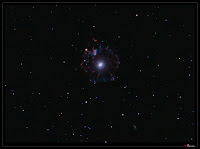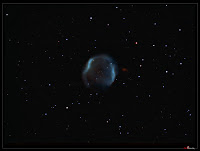COPYRIGHT, PLEASE NOTE
All the material on this website is copyrighted to J-P Metsavainio, if not otherwise stated. Any content on this website may not be reproduced without the author’s permission.
BUY A MUSEUM QUALITY POSTER
BUY A POSTER:https://astroanarchy.zenfolio.com/
Thursday, February 10, 2011
IC 1848, the "Soul Nebula"
IC 1848, the "Soul Nebula"
Ra 02h 51m 36.24s Dec +60° 26′ 53.9"
from the emission of ionized elements, R=Sulfur, G=Hydrogen and B=Oxygen.
Star colors are mixed from the NB channels, Red=H-a, G=O-III and B= 85%O-III + 15%H-a.
It was clear last night for a while. I have shot lots of longer focal length images at last couple of winters.
This time I used a Tokina AT-x 300mm camera lens at full aperture, f2.8, coupled with a QHY9 astronomical camera. This lens delivers image with a spatial resolution of 3,83 arc seconds/pixel and the field of field is
213' x 159' (3,55 x 2,65 degrees). There is now a QHY filter wheel attached, focusing is done by the FocuMax software and a DIY focusing mechanism for camera lenses. Image of it can be seen here:
I had lots of problem with this image. First of all, the CCD was not perfectly perpendicular to an optical axle,
I'll fix that tonight. Secondly my old Meade has some looseness in Ra mechanism, I think it's simply worn out, guiding was very jumpy due that.
Soul Nebula, (Sh2-199, LBN 667) is an emission nebula in constellation Cassiopeia. IC 1848 is a cluster inside Soul Nebula. Distance is about 7.500 light years. This complex is a Eastern neighbor of IC 1805, the "Heart Nebula" and they are often mentioned together as Heart and Soul.
Here is an older image, showing both objects:
Colors for this new image are taken from this older image.
Processing work flow:
Image acquisition, MaxiDL v5.07.
Stacked and calibrated in CCDStack.
Deconvolution with a CCDSharp, 20 iteration, added at 50% weight.
Levels, curves and color combine in PS CS3.
Equipments:
Tokina AT-a 300mm f2.8 @ f2.8
Platform and guiding, Meade LX200 GPS 12" @ f5
Camera, QHY9
Guider, Lodestar
Image Scale, 3,83 arcseconds/pixel
Exposures:
Baader H-alpha 7nm 11x1200s, binned 1x1
Other channels are from older image:
An image showing the size of this object compared to a full Moon.
(Full moon has a diameter of 30', that's 0,5 degrees)
Two older closeup images of the Soul Nebula.
Monday, February 7, 2011
A Supernova Remnant poster
A collection of Supernova remnants in scale
Note! There is now an image of a full Moon as a scale.
I made this poster to show relative sizes of the Supernova remnants. All SNR's in this poster are in same scale.
A full size image, or if an image is smaller, an image holder( dark gray), covers 259' horizontally (4,3 degrees)
NOTE, there are zoomed versions from M1 and IC 443, they are not in scale, the smaller versions of them are in scale with rest of the images.
Images are in HST-palette, mixed from the emission of ionized elements, Sulfur, Hydrogen Oxygen, by a a following method:
Red = S-II, Green = H-alpha and Blue = O-III
A supernova remnant (SNR) is the structure resulting from the gigantic explosion of a star.
The supernova remnant is an expanding shock wave and consists of ejected material expanding from the explosion.
There are two possible routes to a supernova:
There are two possible routes to a supernova:
1. A massive star may run out of fuel and collapsing inward under the force of its own gravity to form a neutron star or a black hole.
2. A white dwarf star accumulate material from a companion star until it reaches a critical mass and undergoes a thermonuclear explosion.
Images, from top Left to a bottom Right
Click thumbnails for large images, technical data behind links
Simeis 147 aka Sh2-240:
http://astroanarchy.blogspot.com/2011/01/reprocessed-supernova-remnants.html (scroll down a bit)
Veil Nebula;
M1, the "Crab Nebula":
IC 443, the "Jellyfish Nebula":
Friday, February 4, 2011
A Planetary Nebula poster
Note! There is now a Gray circle, size of the full Moon, as a scale.
I made this poster to show and understand relative sizes of the nebulae. All Planetary Nebulae in this image are in same scale. Each individual image covers an area of 20' horizontally. (~0,3 degrees) and
they are in "natural" colors, mixed from the narrowband channels. By a following method:
Natural color composition from the emission of ionized elements, R=80%Hydrogen+20%Sulfur, G=100%Oxygen and B=85%Oxygen+15%Hydrogen to compensate otherwise missing H-beta emission. This composition is very close to a visual spectrum.
I have made a similar poster out of supernova remnants as well, you can see it from here:http://astroanarchy.blogspot.com/2011/02/supernova-remnant-poster.html
I have made a similar poster out of supernova remnants as well, you can see it from here:http://astroanarchy.blogspot.com/2011/02/supernova-remnant-poster.html
All images, expect NGC 6302 (Bug Nebula), are shot from my urban observatory in very centrum of city Oulu. NGC 6302 was shot with a remote telescope, 16" RCOS, from Australia.
All of the images are Planetary Nebulae.
Planetary nebulae are shells of gas, shed by stars late in their life cycles after using up all of their nuclear fuel. The gas is illuminated and ionized by its extremely hot central star, a core left from the original star.
Our own star, the Sun, is expected to undergo the same process in a couple of billion years.
Images, from top Left to a bottom Right
Click thumbnails for large images, technical data behind links
Click thumbnails for large images, technical data behind links
M27, the "Dumbbell Nebula":
M76, the "Little Dumbbell Nebula":
http://astroanarchy.blogspot.com/2010/11/m-76-little-dumbbell-nebula.html

PK 164+31.1, Jones-Emberson 1:

PK 164+31.1, Jones-Emberson 1:
M57, the "Ring Nebula":
http://astroanarchy.blogspot.com/2010/10/m57-ring-nebula-project-finalized.html

Sh2-188:
http://astroanarchy.blogspot.com/2010/11/sh2-188-project-finalized.html
NGC 6543, the "Cat's Eye Nebula":
http://astroanarchy.blogspot.com/2010/10/m57-ring-nebula-project-finalized.html

Sh2-188:
http://astroanarchy.blogspot.com/2010/11/sh2-188-project-finalized.html
NGC 6543, the "Cat's Eye Nebula":
http://astroanarchy.blogspot.com/2011/01/cats-eye-nebula-reprocessed.html

Sh2-274, the "Medusa Nebula":
http://astroanarchy.blogspot.com/2011/02/medusa-nebula-sh2-271-project-finalized.html
Jones 1:
http://astroanarchy.blogspot.com/2010/11/jones-1-extreme-dim-planetary-nebula.html

NGC 6302, the "Bug Nebula":

Sh2-274, the "Medusa Nebula":
http://astroanarchy.blogspot.com/2011/02/medusa-nebula-sh2-271-project-finalized.html
Jones 1:
http://astroanarchy.blogspot.com/2010/11/jones-1-extreme-dim-planetary-nebula.html

NGC 6302, the "Bug Nebula":
Thursday, February 3, 2011
M27, the "Dumbbell Nebula", as a Stereo Pair 3D
3D-experiment with the M27
Parallel vision 3D
NOTE! This is a personal vision about forms and shapes, based on some known facts and an artistic impression.
Labels:
stereo images
Subscribe to:
Posts (Atom)



























